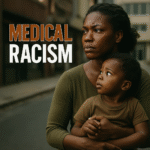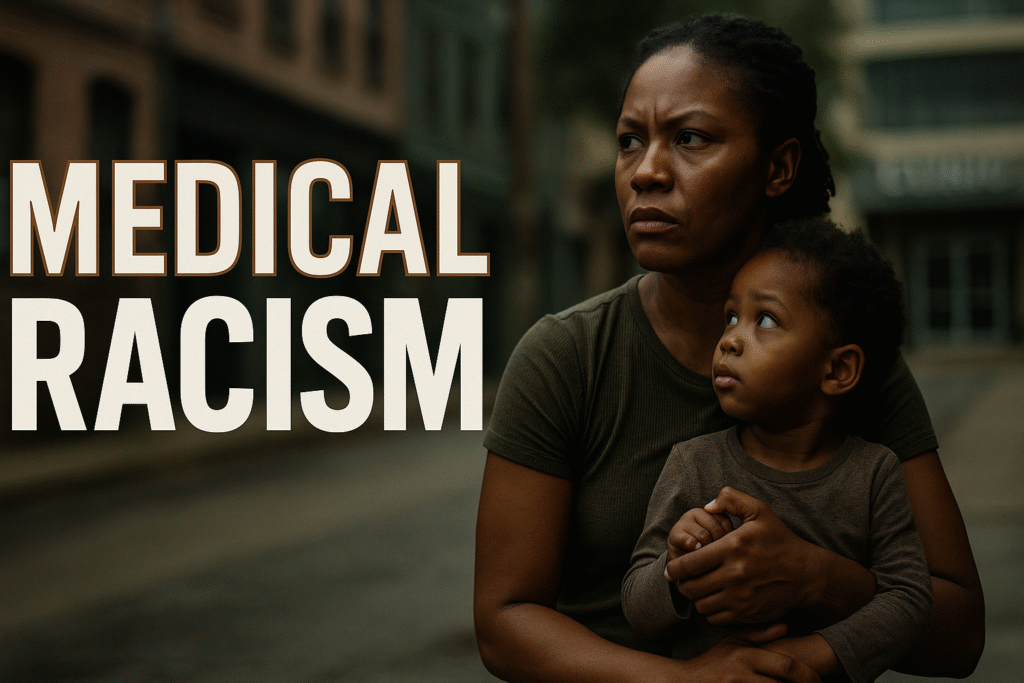

Vaccine Myths and Medical Racism
By Darius Spearman (africanelements)
Support African Elements at patreon.com/africanelements and hear recent news in a single playlist. Additionally, you can gain early access to ad-free video content.
When the Afro-American Newspaper, a trusted voice in our community since 1892, published an explainer pushing back against false claims that vaccines cause autism, it did more than just correct a scientific error (wikipedia.org). It touched on a painful truth. The article highlighted how these fear campaigns often target Black parents. We are a community that already faces systemic medical racism and unequal access to healthcare. This is not just a story about a debunked medical study. It is the story of how historical wounds make our communities vulnerable to new dangers. The fear of autism from vaccines is a myth, but the risk it creates is very real, threatening to increase disease in neighborhoods where the healthcare system already feels fragile.
The roots of this specific fear trace back to a single, fraudulent study published in 1998 in a respected journal, *The Lancet* (badgut.org). A British doctor named Andrew Wakefield claimed to have found a link between the measles, mumps, and rubella (MMR) vaccine and a new syndrome he called “autistic enterocolitis.” His research was based on only 12 children, a tiny sample size (badgut.org). Nevertheless, the claim created a global firestorm. Parents, understandably concerned, began to question the safety of a routine childhood vaccination. The media amplified the scare, and a dangerous myth was born.
A Lie That Won’t Die: Vaccine Fraud
The foundation of the vaccine-autism myth was not just weak; it was completely rotten. Investigations soon revealed Andrew Wakefield’s research was an elaborate fraud. He had manipulated the data to fit his theory. Furthermore, he had a massive, undisclosed financial conflict of interest. Lawyers preparing to sue vaccine manufacturers were paying him, and he was also trying to patent his own single-shot measles vaccine that would benefit from fear of the combined MMR vaccine (wikipedia.org). Wakefield even subjected the children in his study to painful and unnecessary medical procedures, like colonoscopies, without proper ethical approval (wikipedia.org).
The scientific community swiftly moved to correct the record. In 2004, ten of Wakefield’s twelve co-authors formally retracted the paper’s interpretation, stating there was not enough data to establish a causal link (wikipedia.org). By 2010, *The Lancet* issued a full retraction, calling the study “utterly false” (theguardian.com). That same year, the UK General Medical Council found Wakefield guilty of serious professional misconduct and stripped him of his medical license (wikipedia.org). Despite this complete debunking, the damage was done. In the United Kingdom, MMR vaccination rates dropped from over 90% to below 70% in some areas (wikipedia.org). Consequently, this led directly to a major resurgence of measles, a disease that had been nearly eliminated (wikipedia.org).
Measles Cases in England and Wales
Measles cases skyrocketed after Wakefield’s fraudulent paper was published in 1998 (wikipedia.org).
Echoes of Mistrust: Medical Racism’s Shadow
For Black communities, the persistence of vaccine misinformation is not just about one doctor’s fraud. It is deeply connected to a long and painful history of medical racism that has created a profound and justified mistrust of the healthcare system. The most infamous example is the Tuskegee Syphilis Study, which ran for 40 years from 1932 to 1972 (britannica.com). The U.S. Public Health Service deceived nearly 400 Black men in Alabama who had syphilis. The men were told they were receiving free treatment for “bad blood” but were never given a real diagnosis or effective medicine, even after penicillin became the standard cure (britannica.com). Instead, doctors watched them suffer and die to study the disease’s progression.
This betrayal was not an isolated incident. In 1951, doctors at Johns Hopkins Hospital took cervical cancer cells from Henrietta Lacks, a Black woman, without her knowledge or consent (labxchange.org). Her cells, named “HeLa,” became one of the most important tools in modern medicine, contributing to the polio vaccine, cancer treatments, and gene mapping (labxchange.org). However, her family received no recognition or compensation for decades. Before that, in the 19th century, Dr. J. Marion Sims, the so-called “father of modern gynecology,” performed brutal experimental surgeries on enslaved Black women without anesthesia (plannedparenthood.org). He operated under the racist and false belief that Black people do not feel as much pain as white people, a dangerous bias that shockingly still exists in medicine today.
The System Itself: Healthcare Disparities
The legacy of these historical abuses is seen in today’s healthcare system. Black patients continue to face major disparities in both access to and quality of care. These inequities are often driven by implicit biases, which are the unconscious attitudes and stereotypes that healthcare providers may hold. These biases can affect their decisions in ways they may not even realize (uconn.edu). Implicit bias is not about a doctor being overtly racist; rather, it is about how ingrained societal stereotypes can lead to different treatment outcomes. For example, studies show these biases can lead to doctors dismissing the symptoms of Black patients, spending less time with them, or providing less pain medication compared to white patients with the exact same condition (uconn.edu).
The statistics paint a grim picture of these systemic failures. Black Americans have a life expectancy nearly five years shorter than white Americans (wikipedia.org). Black infants are more than twice as likely to die before their first birthday as white infants (cdc.gov). Black mothers are nearly three times more likely to die from pregnancy-related causes than white mothers (cdc.gov). Furthermore, Black patients are less likely to have health insurance and more likely to report experiencing racial discrimination from their healthcare providers (wikipedia.org). This ongoing reality of poorer care and worse outcomes reinforces the historical mistrust, creating fertile ground for misinformation to take root.
Maternal Mortality Disparity (2017-2019)
Black women are nearly three times more likely than white women to die from pregnancy-related causes (wikipedia.org).
The Real Science Behind Autism Causes
To effectively combat misinformation, it is important to replace the lie with the truth. The global scientific and medical communities are in complete agreement: vaccines do not cause autism (autismspeaks.org). Dozens of large-scale studies involving millions of children around the world have been conducted, and they all consistently show no link between any vaccine, or vaccine ingredient, and Autism Spectrum Disorder (ASD) (chop.edu). The original claim by Wakefield was based on fraud, and no credible research has ever been able to replicate his supposed findings.
Instead, scientists understand that autism is a complex neurodevelopmental condition that has no single cause. Research points to a combination of genetic and environmental factors that influence a child’s development, often before they are even born (autismspeaks.org). Autism is known to be highly heritable, meaning that genetics play a major role and it often runs in families (autismspeaks.org). Certain environmental factors, such as advanced parental age or complications during birth, may also increase risk by interacting with a person’s genetic predispositions (nih.gov). This true scientific understanding shows that autism is a part of natural human variation, not something caused by a vaccine designed to protect a child’s health.
Fighting Back: Advocacy and Information
This is why the work of health advocates is so critical. Organizations like the Afro-American Newspaper are using their platforms to deliver clear, research-backed information to the community (wikipedia.org). Their role is not just to publish articles but to engage in a sustained effort to rebuild trust. These efforts involve multi-faceted strategies. For example, advocacy groups conduct direct community outreach programs, hosting workshops and town halls to provide accurate, culturally relevant health information in a trusted setting (arizona.edu). This grassroots approach helps counter misinformation where it spreads most effectively: among friends, family, and neighbors.
These advocates also develop and distribute educational materials that are easy to understand, breaking down complex science into accessible facts about vaccines and preventive care. In addition, they run public awareness campaigns using both traditional media and social media to amplify correct health messages and challenge the myths that circulate online (arizona.edu). This work is essential because simply presenting facts is not enough. To be effective, the information must come from a trusted source that acknowledges the community’s valid reasons for mistrust and speaks to our unique history and present-day challenges. It is about healing the relationship between our community and the medical system.
Infant Mortality Rate (2021)
The infant mortality rate for Black infants is more than double that of white infants (cdc.gov).
A Path Forward: Systemic Change in Healthcare
Ultimately, debunking myths is only one part of the solution. To truly protect our communities, we must address the deep-rooted medical racism that allows this misinformation to thrive. This requires broad, systemic changes at both the institutional and policy levels. Governments are beginning to take steps, such as proposing legislation to expand Medicaid and other health insurance programs to improve access to care for underserved communities (weforum.org). Closing the insurance gap is a fundamental step toward health equity. Lasting change, however, will require much more.
Healthcare institutions must commit to meaningful diversity, equity, and inclusion (DEI) initiatives. This includes mandatory training to address implicit bias in medical schools and clinical practice (uchicago.edu). Furthermore, there is a growing push to increase the representation of Black and other minority healthcare professionals. Seeing a doctor who looks like you and understands your culture can significantly improve communication, build trust, and lead to better health outcomes (uchicago.edu). Investing in community-based healthcare models that bring resources directly into marginalized neighborhoods is also crucial. The fight against misinformation is connected to the broader struggle for social justice. To achieve true health equity, we must dismantle the racist systems that have caused so much harm for so long.
About the Author
Darius Spearman is a professor of Black Studies at San Diego City College, where he has been teaching for over 20 years. He is the founder of African Elements, a media platform dedicated to providing educational resources on the history and culture of the African diaspora. Through his work, Spearman aims to empower and educate by bringing historical context to contemporary issues affecting the Black community.
